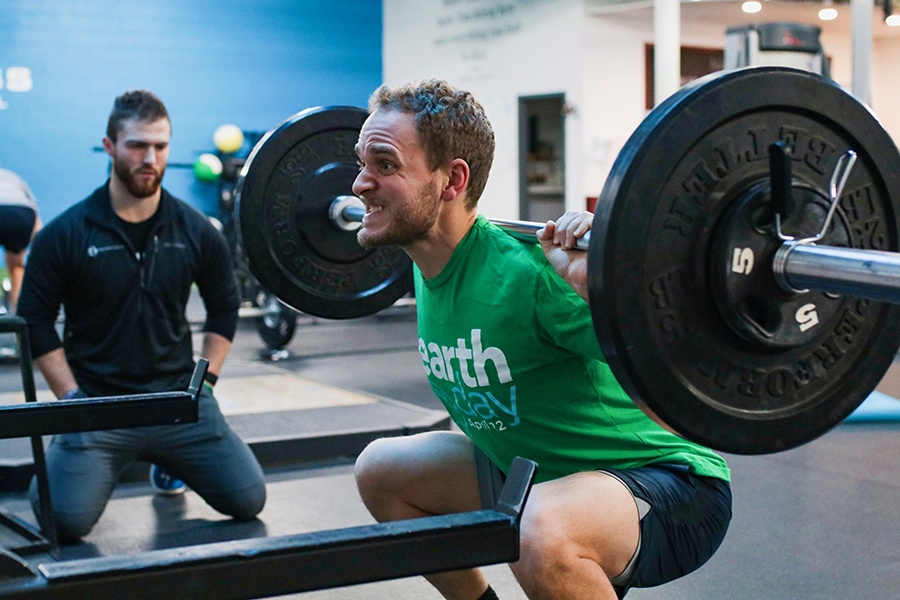Ask the Expert: What’s the Right Squat Form for Me?
We asked a strength coach at Achieve Fitness.

Photo provided
If you’re a regular at bootcamp classes or enjoy testing out your strength in the free weight area with a personal trainer, you’ve probably been told the same few things countless times when you get ready to perform the squat, long considered the bread and butter of lower body exercises. Things like: “Make sure your weight is in your heels” or, “Don’t let your knees go past your toes,” or even, “Your feet should be no farther than shoulder-width apart.” While all great cues for a certain time and place, and definitely things to think about, it can feel like a blizzard of conflicting information. What should you actually be thinking about when you gear up to perform one of the best compound movements there is? After all, squats work almost every single muscle in your body and carry over into essentially everything we do in a day, so you best make sure you’re doing them right.
According to Ted Andrews, a strength coach at Achieve Fitness, what you should think about varies widely, but it really boils down to the relationship of your feet with the ground. When it comes to strength training, your feet are pretty darn important. If you don’t have a strong base of support, how can you expect to have a strong anything else?
Ask the Expert: What’s the right squat form for me?
The answer: Look at what your feet are doing.
The details:
“Your feet are the foundation of the squat,” Andrews says, “and are such a big component to ideal performance.” Although there are many things you should really be thinking about when it comes to squatting, it all begins with what your feet are doing in relation to the floor.
Andrews says you want to think about three key points of pressure on the foot while squatting. Essentially, you want to think of your foot as a claw that is gripping the ground. The three points being:
- The ball of your foot directly behind the big toe.
- The ball of the foot directly behind the little toe.
- And your heel.
You may have been told to always keep your weight in your heels during this lift, but Andrews says this cue came from the belief that squatting was bad for your knees. “And by sitting backward and keeping the body weight balanced on the back half of the foot, the knees would be kept safe.”
Not only does he say this is untrue, but that “the cue does a disservice to the squatter and prevents them from maximizing their squatting potential.”
Building up from the floor, you should be concerned with how wide you set your stance. Andrews says this will vary for everyone because everyone’s bodies are built differently. For folks with longer limbs, a wider stance may be ideal, but that most people find their ideal stance is somewhere between shoulder and hip width apart. Same goes for whether or not you point your toes outward or keep them pointing straight—it’s highly dependent on the individual’s hip anatomy.
If you have a hard time figuring out why your squat feels off, Andrews says to take your shoes off. “Certain shoes that have larger, more cushiony bottoms are not going to be ideal for squatting because they diminish the sense of feel the foot gets from the floor,” he says. So those super supported running shoes that are great for logging miles not be so great for when you go to put a barbell on your back.
“The shoe may also absorb some of the force the legs produce,” Andrews explains. “And it may also create some unwanted movement side to side of the foot and ankle, which could cause irritation or injury under load.”
When Andrews is coaching a new client on a squat, he first assesses what their knees are doing over their feet and what position they take with their stance. “I’d say a majority of the time, I will have people widen their stance, position their toes out slightly, and practice pushing their knees apart.” He’s looking for them to say words like: balanced, fluid, smooth, stable, comfortable, strong, etc., anytime he makes a modification.
At the end of the day, this is largely a self-experiment (as is anything with health and fitness.) And if something isn’t comfortable, or not working the way it should, it doesn’t mean you’re broken—it just means you need to do a little more experimentation.


